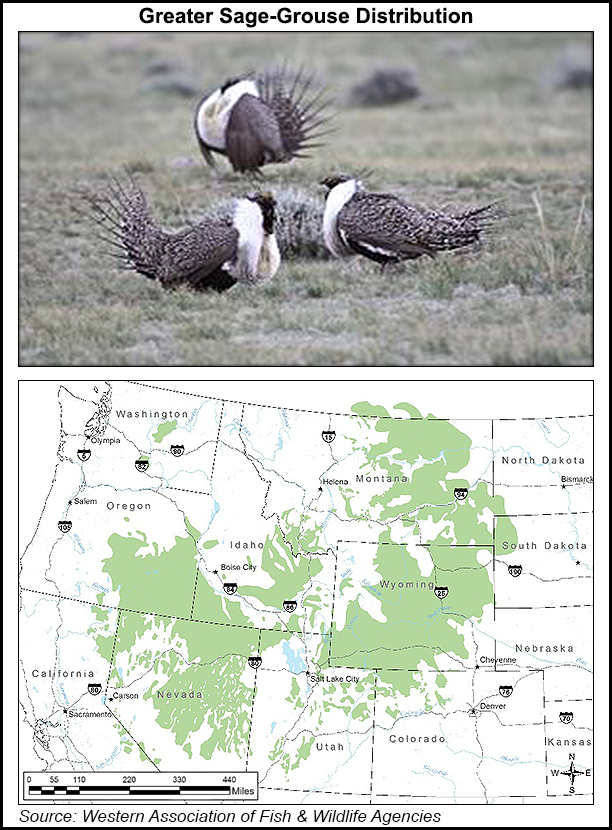Regulatory | E&P | NGI All News Access
BLM Proposes Cutting Restrictions on Oil, Gas Leasing in Sage Grouse Habitat
The Interior Department’s Bureau of Land Management (BLM) is seeking public comment about a proposal to reduce restrictions on oil and natural gas leasing in several western states with greater sage grouse habitat.

Six separate notices that outline a draft resource management plan (DRMP) amendment and a draft environmental impact statement (DEIS) are scheduled to be published by the Environmental Protection Agency in Friday’s Federal Register, which would kick off a 90-day public comment period. The BLM said it may also hold hearings or meetings over its proposal.
Five of the notices cover Colorado, Idaho, Oregon, Utah and Wyoming, while a sixth notice includes Nevada and northeastern California. The BLM said the Trump administration wants to “better align” its efforts at managing and conserving the ground-dwelling bird’s habitat with state regulatory agencies.
“We are committed to being a good neighbor and respect the state’s ability to manage wildlife, while recognizing the tremendous investments of effort into improving greater sage grouse populations over the last decade,” Interior Deputy Secretary David Bernhardt said Wednesday. “We look forward to receiving comments on the draft.”
The DRMP and DEIS would evaluate two alternatives in detail: a no action alternative, and an action alternative, aka the Management Alignment Alternative (MMA). BLM said an MMA for Colorado “would adjust restrictions on oil and gas leasing near sage grouse leks and revise the language for waivers, exceptions and stipulations in leases to reflect the state’s authority over wildlife management, while clarifying the application of lek buffers.”
Oil and gas leasing was not specifically mentioned in any of the other five state notices. Meanwhile, the notices for Idaho, Utah, Wyoming and Nevada and northeast California said sagebrush focal areas included in conservation plans in 2015, during the Obama administration, would be removed.
The governors of Colorado, Idaho, Nevada, Utah and Wyoming — all Republicans, save for Colorado Gov. John Hickenlooper — said they supported the BLM’s action.
“I am anxious to find a long-term solution that will allow the sage grouse to thrive in Utah,” said Utah Gov. Gary Herbert. “The revised plans will better address localized threats while allowing for the increased flexibility that will ensure the viability of the sage grouse.”
Idaho Gov. Butch Otter added that the Trump administration “is showing greater respect for on-the-ground impacts of government actions on people and communities while restoring the important role of federalism.”
But environmental groups voiced concern over the proposal. “Westerners worked hard on a compromise to keep the sage grouse from being listed as an endangered species and to conserve sagebrush country,” said National Wildlife Federation spokeswoman Tracy Stone-Manning. “We’re still reviewing the proposed amendments…but we remain convinced that not only is this an unnecessary extra process, some of the changes could undo all that hard work and put us on a path that no one wanted — the bird on the endangered species list and the use of our public lands restricted. It’s a disappointing and dangerous mistake.”
The Center for Biological Diversity and the Western Watersheds Project filed a lawsuit last Monday in federal district court over the Trump administration’s actions on the sage grouse, including plans unveiled last October to reconsider protections for the bird. According to the complaint in U.S. District Court for the District of Idaho, the groups object to BLM offering “hundreds of thousands of acres” for oil and gas leasing. The case is Western Watersheds Project et al v. Ryan Zinke et al, No. 1:18-cv-187.
“Over a million acres of similar lease sales are slated to be offered and sold by BLM in coming months,” the plaintiffs said. “Individually and cumulatively, these oil and gas leases threaten substantial degradation and fragmentation of key sage grouse habitats, and harm to sage grouse populations.”
Last June, Interior Secretary Ryan Zinke ordered a review of greater sage grouse protection plans, in part to determine whether any protections were interfering with energy development on public lands.
© 2024 Natural Gas Intelligence. All rights reserved.
ISSN © 2577-9877 | ISSN © 2158-8023 |
